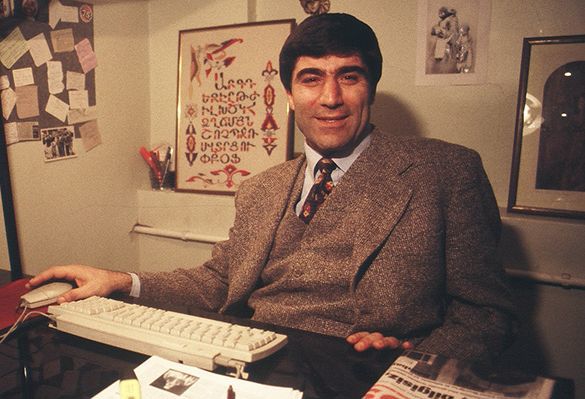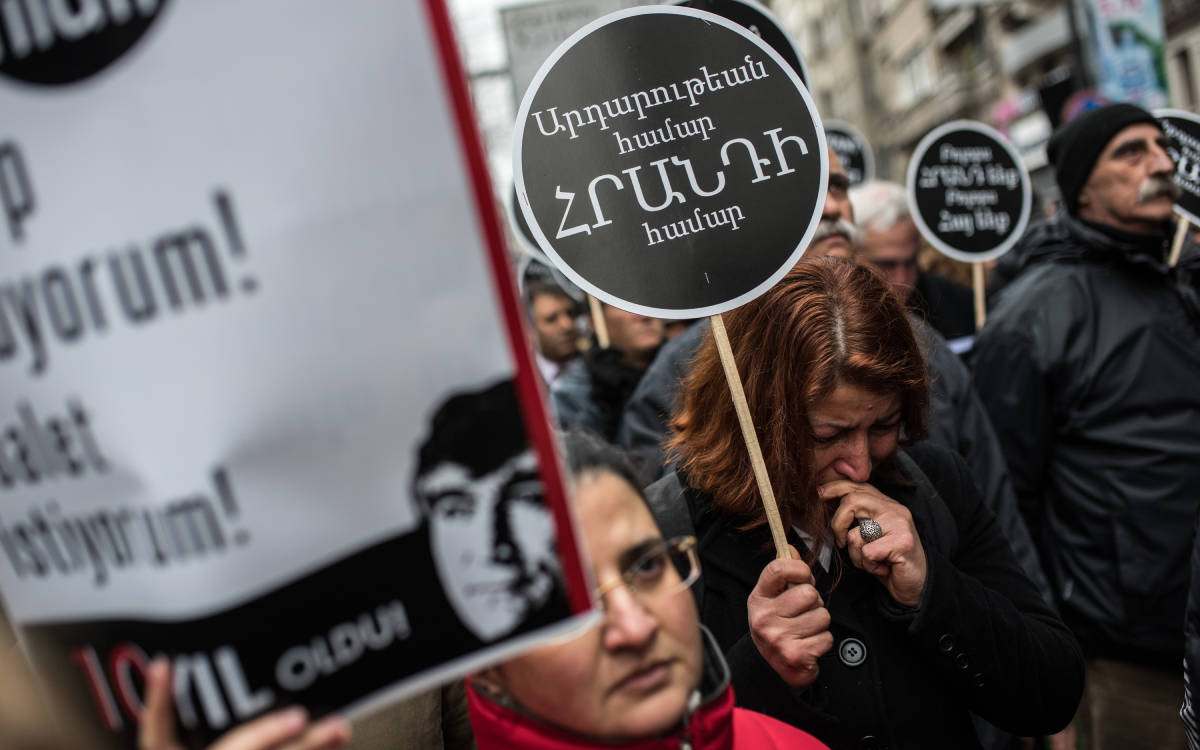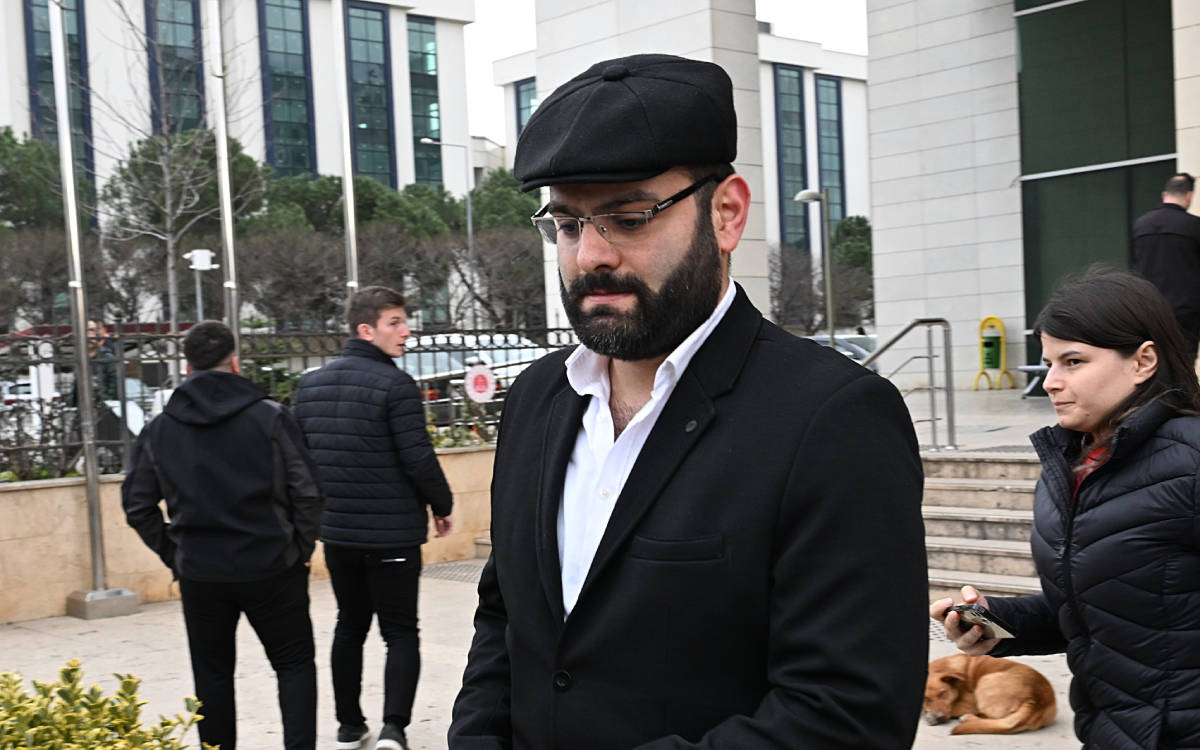On the 17th anniversary of his assassination, the founder and Editor-in-Chief of Agos newspaper published in Armenian and Turkish, Hrant Dink will be commemorated at the place where he was shot. The memorial will take place today (January 19), as it does every year, in front of the former Agos office at 3:00 pm.
Friends of Hrant made the following call regarding the commemoration:
The assassin of Hrant Dink was 17 years old when he shot Hrant Dink 17 years ago. Today, he freely roams among us. Those who ordered the shooting that day are still in their positions. A shameful farce was presented under the guise of a trial. The Hrant Dink Murder stands as a significant stain in the history of this country. We object, we rebel, we demand justice.
Side by side, growing in number, and raising our voices louder, we express our protest and commemorate Hrant Dink on the 17th anniversary of the murder. On Friday, January 19th, at 3:00 PM, we will be at the 23.5 Memory Space (former Agos office) in front of the place where he was shot.
About Hrant Dink
Journalist, author and human rights defender.
He was born on September 15, 1954, in Malatya. At the age of five, he came to İstanbul with his family. Following his parents' separation, he, along with his two brothers, started living in the boarding facility of the Armenian Protestant Church in Gedikpaşa.
The three siblings continued their primary education at the Incirdibi Primary School affiliated with this church. During the summers, they stayed at the school's camp in Tuzla. He attended Bezciyan Middle School and completed high school at the Surp Haç Tıbrevank Boarding School in Üsküdar, graduating from Şişli High School.
He married Rakel Yağbasan, a member of the Armenian Varto Tribe, whom he met in primary school, and they had three children. He pursued studies in Zoology at İstanbul University Faculty of Science and later studied Philosophy. He abandoned his dreams of establishing a chair on 'Philosophy of Biology' at the university to actively engage in the developing leftist politics in Turkey. Concerned that his political activities, when associated with his Armenian identity, might harm the community, he legally changed his name to "Fırat" by court order.
During this period, Hrant and Rakel Dink took over the management of the Tuzla Children's Camp where they grew up, providing care for numerous orphaned Armenian children. After the state seized control of Tuzla Camp, accusing it of being a "breeding ground for Armenian militants," Dink was arrested and detained three times due to his political views.
Operating a bookstore with his siblings, Dink, using the pseudonym Çutak, started writing critical articles in the Armenian daily Marmara newspaper in the 1990s, addressing books on Armenian history published in Turkey. The weekly Agos newspaper, whose first issue was published on April 5, 1996, made history as the first Turkish-Armenian newspaper in İstanbul. Named after the saying "Agos," which means "the place where the plow opens the soil, seeds are planted, and abundance springs forth" in both languages, the newspaper adopted an editorial policy based on this symbolism of abundance and partnership.
The main goals were to show solidarity with the segment of the Turkish-Armenian community that did not know the mother tongue, to voice the issues of Turkish-Armenians with the state in their own words, to garner support from the broader public, and to share Armenian culture and history with the Turkish society from its primary source.
Agos, known for its left-wing and opposition identity, not only criticized the existing problematic structure within the Turkish-Armenian community but also emphasized the importance of civilianization and transparency. Hrant Dink himself proposed alternative social projects through the pages of Agos.
Hrant Dink, with his enlightening discourse during Agos' publishing life, increasingly drew the attention of the public. He also served as a columnist for Yeni Yüzyıl and BirGün newspapers.
He brought to the agenda issues such as the establishment of neighborly relations between Turkey and Armenia, the opening of the border, supporting Turkey's democratization process, and fostering a discourse that speaks empathetically, respecting the dignity of both nations, regarding the events of 1915, over those who survived and not over the numbers of those who have died. He also advocated for the proliferation of alternative publications on the subject, apart from the official stance.
Participating in numerous conferences in the United States, Australia, Europe, and Armenia, Dink played a role in initiating questioning processes within both the Armenian world and various Western countries regarding Armenian identity and Turkish-Armenian relations, considering their historical roles.
Targeting campaigns and lawsuits

The legal case opened due to Hrant Dink's speech at a conference in Urfa in 2002 concluded with his acquittal on February 9, 2006. The real starting point of the intense legal process for Dink, even though he was not directly the subject of the lawsuit, was the news article about Sabiha Gökçen, the adopted daughter of Atatürk, which he published in Agos on February 6, 2004. The article claimed that Sabiha Gökçen had Armenian origins and had relatives in Armenia, bearing Hrant Dink's signature.
In the news article titled "The Secret of Sabiha Hatun," Hripsime Sebilciyan Gazalyan, an Armenian citizen originally from Gaziantep, claimed to be the niece of Sabiha Gökçen. She asserted that Atatürk's adopted daughter Sabiha Gökçen was actually an Armenian orphan taken from an orphanage.
After this news was quoted from Agos on February 21, 2004, and featured on the front page of Hürriyet with the headline "Sabiha Gökçen or Hatun Sebilciyan?" on the same day, the General Secretariat of the General Staff issued a strongly-worded statement on February 22, 2004.
Immediately after the statement from the General Secretariat of the General Staff, Hrant Dink was called to the İstanbul Governorate. In the office of Deputy Governor Erol Güngör, two individuals, claiming to be close relatives of the Deputy Governor (whose identities remain unknown), "warned" Hrant Dink. Following this meeting, a targeting campaign in the radical right-wing media against Hrant Dink commenced.
A sentence extracted from the February 13, 2004 installment of Hrant Dink's eight-part series on Armenian identity, published in the 'Şapparigce' column, which originally presented a critical approach towards the Armenian Diaspora, was taken out of context. It was then presented with the stance that "Hrant Dink is insulting Turkish identity," leading to a new lawsuit. The isolated sentence was: "The clean blood that will replace the poisonous blood to be drained from the Turk is present in the noble vein that the Armenian will establish with Armenia."
Following the lawsuit opened against Hrant Dink for the crime of "publicly humiliating and degrading Turkishness," despite the expert report appointed by the court stating that there was no criminal element in the article, Hrant Dink was sentenced to six months in prison by the Şişli 2nd Criminal Court on October 7, 2005. The decision was upheld by the Court of Cassation 9th Criminal Chamber, making the prison sentence against Hrant Dink final. The Chief Public Prosecutor's Office at the Court of Cassation objected to this decision, but the objection was rejected by the Court of Cassation Criminal General Assembly. A new case was filed against Hrant Dink for "attempting to influence the judiciary" based on his statements regarding the decision.
During the first hearing of the trial, both outside the courthouse and in the corridors and courtroom, individuals who wanted to intervene in the case staged protest demonstrations. Hrant Dink could only enter the courthouse hall through a corridor created by the police, accompanied by the police and his lawyer. During this time, there were individuals attempting to attack him, insult him, and spit at him. The group filling the courtroom threw coins and pens at Hrant Dink's lawyers, insulted and threatened them. After the hearing, while Hrant Dink left the courthouse in a police vehicle, the lawyers were placed on a police bus in front of the courthouse, protecting them from the attacks of the angry crowd.
Meanwhile, on February 26, 2004, a group led by Levent Temiz, the İstanbul Grey Wolves (Ülkü Ocakları) chairperson, gathered at the door of Agos, chanting slogans such as "Love it or leave it," "Down with ASALA," and "We can come one night unexpectedly." A similar demonstration took place a few days later in front of Agos by a group calling themselves the "Federation for the Struggle Against Baseless Armenian Claims."
After Hrant Dink's article titled "Hoş Gidişler Ola" published in BirGün newspaper, he was targeted by Yeniçağ newspaper with the headline "Look at the Armenian" in its issue dated October 9, 2004. Following this headline, the Press Council High Board decided to warn Yeniçağ newspaper, stating that the language used by the newspaper could encourage violence against the author.
Finally, a lawsuit was filed against Hrant Dink, Editor-in-Chief Arat Dink, and Publisher Sarkis Seropyan due to the news article titled "1 Vote Against 301," published in the July 21, 2006 issue of Agos. In this article, a quote from Dink's statement to Reuters was cited, where he said, "Of course, I say it is genocide. Because the result itself defines and names it. You see that a people who have lived in these lands for four thousand years has now disappeared with these events." It was claimed that this quote, under Article 301 of the Turkish Penal Code, "insulted Turkishness."
All these legal processes continued even after Hrant Dink's assassination on January 19, 2007, when he was shot in front of his newspaper. Following the assassination, the cases against Hrant Dink were dropped. However, in the last trial, the Şişli 2nd Criminal Court sentenced Arat Dink and Sarkis Seropyan to one year in prison each on October 11, 2007.
The statement "Since the courts have found that Arat Dink and Sarkis Seropyan have published news accusing the Turkish nation of genocide, and considering the individual characteristics of the defendants and their actions, they should be punished separately" and the fact that no lawsuits were filed against any national press and media organizations quoting this statement sparked significant controversies. (HA/PE)






